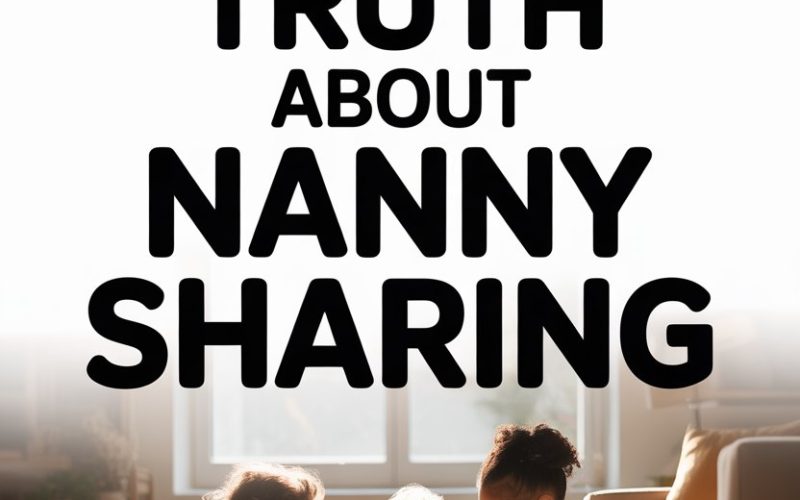Picture it: another day, another frantic dash from the office to collect your tot before the nursery staff switch off the lights and start charging overtime.
Then, a whisper reaches your ear on the playground: “We’re nanny sharing now—changed our lives.”
Cue intrigue. Cue suspicion. Is this some sort of secret club for parents with colour-coordinated Tupperware? Or have you just stumbled onto the parenting world’s best-kept secret?
Buckle up. It’s time to dish the dirt on nanny sharing.
What Is Nanny Sharing, Really?
No, it’s not a timeshare for nannies, nor do you swipe left or right for your perfect childcare match.
Nanny sharing is when two (or sometimes more) families hire the same nanny to look after their children, usually splitting the costs and, occasionally, the snacks.
Sometimes everyone gathers under one roof, and sometimes the little ones bounce between homes like a preschooler’s version of The Amazing Race.
This isn’t a newfangled trend invented by millennial parents with too many tabs open.
It’s a practical solution for those who crave higher-quality childcare, more flexibility, and a social life for their children—without having to sell a kidney to afford it.
Why Parents Whisper About It
There’s a reason you don’t see “Ask Me About My Nanny Share” bumper stickers on the school run. Nanny sharing can feel a bit like an underground society, with secret handshakes involving reusable coffee cups.
Some parents worry about appearing stingy or, even worse, ‘that mum’ who’s always looking for a loophole. Others just don’t want to admit that juggling work, life, and childcare is less “Lean In” and more “Hold on by your fingernails.”
A study published in Child & Family Social Work found that parents often hesitate to talk openly about cost-saving childcare arrangements for fear of being judged.
Forget all that. You’re not cheap—you’re clever.
The Savings (and the Math You Didn’t Know You’d Need After Uni)
Yes, splitting a nanny’s wages with another family means more disposable income for coffee or, let’s be honest, therapy. But don’t get too excited about the 50/50 split just yet.
Nannies expect to earn more when caring for two families’ children, but most families still pay significantly less than they would for a solo nanny arrangement.
For example, if a full-time nanny costs £14 an hour, two families might each pay £8. Not quite half, but still friendlier on the wallet than solo care, and your child gets a playmate thrown in for free.
Here’s the twist: taxes, National Insurance, and pension contributions don’t magically vanish. You’re still a legal employer, and yes, you need to register with HMRC.
It’s not just a handshake in the park. Sneaky, I know.
The Legal Minefield No One Warns You About
You thought the bedtime routine was complicated? Welcome to the wild world of employment law. When two families employ the same nanny, each is technically their employer.
Both are responsible for contracts, payroll, and insurance.
And if you’re thinking you can just wing it, ACAS has a whole page outlining the risks, from tax evasion (naughty) to falling foul of employment rights (even naughtier).
This means proper contracts, agreement on holidays, sick pay, and—brace yourself—the nightmare that is figuring out who covers what if someone’s child decides to lick a door handle and gets ill for a week.
Who Decides the Rules?
The honest answer: everyone, if you want it to work. Nanny sharing is a team sport.
Are you the family who sends organic quinoa snacks, or are you perfectly content with raisins and hope? Is screen time allowed? Are naps sacred, or do you run a free-range household?
Every arrangement needs a nanny share agreement, written down and agreed upon. Spell out pick-up times, locations, dietary quirks, discipline strategies, and what happens if one family is on holiday.
Unspoken rules are just waiting to trip you up. Trust me, nothing brings out parental pettiness faster than a dispute over who used the last baby wipe.
The Social Side: Toddlers and Grownups Alike
It’s not all spreadsheets and passive-aggressive WhatsApp groups. The magic happens when children find a buddy their own age, and you get a fellow traveller in the trenches of parenthood.
Research published in Early Child Development and Care shows children thrive with regular peer interaction, even as young as nine months old.
A nanny share means the little ones learn to share, take turns, and occasionally form alliances against broccoli.
As for the grownups, having another family in the mix offers a built-in support network, potential new friends, and—if you play your cards right—a backup driver for when you’re stuck on conference calls.
When It All Goes Wrong
Let’s not sugar-coat it. Nanny shares can get messy. Disagreements pop up about everything from screen time to sick days to whose house has the superior snack cupboard.
If one child is ill, do you cancel the nanny? Does the healthy child lose out? Or do you risk the kind of cross-contamination usually reserved for medical dramas? (For the record, NHS guidance suggests keeping sick children at home to avoid spreading germs.)
And when it comes to discipline, things get personal fast. Your “gentle parenting” might look like “laissez-faire chaos” to the other family.
Honest conversations upfront—and a bit of flexibility—are worth their weight in goldfish crackers.
Finding the Right Family (And Nanny)
Compatibility is everything. Think of it like setting up your child’s first band: you want everyone on the same page about nap times, musical taste, and whether raisins are an acceptable meal.
Many parents find nanny share partners through local parenting groups, nurseries, or even apps like Bubble that specialise in matching families for childcare.
Arrange a few low-stakes playdates to see if the kids click—and more importantly, if you can stand the other parents at 7am on a Monday.
Choosing a nanny who’s up for the challenge is just as crucial. Not everyone is comfortable wrangling multiple children from different households, especially if the families have wildly different expectations.
Look for experience, references, and a sense of humour. Anyone who can make two toddlers eat peas at the same time deserves a medal.
The Schedule Shuffle
Nailing down a workable schedule may take longer than naming your baby. Both families need to agree on days, drop-off locations, pick-up times, and who provides snacks.
Some families alternate hosting weeks, while others stick to one “base camp.”
Flexibility helps, but keeping a shared online calendar (try Cozi or Google Calendar) can preserve your sanity. Don’t rely on your memory—you know it’s already full of Paw Patrol theme tunes and a hundred unread emails from the school.
What Nannies Actually Think
Before you pop the confetti, check in with the person at the heart of all this: the nanny. Some adore the variety and camaraderie of nanny shares, while others prefer the simplicity of a single-family arrangement.
A survey by Nannytax found that most nannies expect a higher hourly rate when caring for multiple children from different families—but many welcome the chance to engage children in group activities, outings, and social development.
Be up front, respectful, and involve your nanny in the planning process. If they feel valued and fairly compensated, they’ll stick with you through every tantrum, teething episode, and failed baking project.
Is It Really Worth It?
Once the initial admin, negotiation, and WhatsApp drama is done, the payoff can be huge. Lower costs, more personalised care, and happy children with built-in best friends (or, at the very least, frenemies).
For working parents, especially those without a grandparent on standby or a gold-plated nursery budget, nanny sharing bridges the gap between affordability and quality.
And while there are definitely pitfalls, a little openness and willingness to compromise go a long way.
The Secret’s Out
Nanny sharing isn’t some forbidden rite whispered about in the soft play corners—it’s a practical, community-driven solution that’s worked for years, hidden in plain sight.
Sure, it takes a bit of work, a heap of honest chats, and the patience to get through a group chat filled with memes, but the rewards speak for themselves.
Sharing a nanny might not solve all your parenting woes (no arrangement has managed to stop toddlers hiding peas in their socks), but it can carve out breathing room where you need it most.
Maybe even a little time for yourself—imagine that.
And the next time someone asks how you manage it all, you can just smile knowingly.
Your secret’s safe with us—well, sort of.





